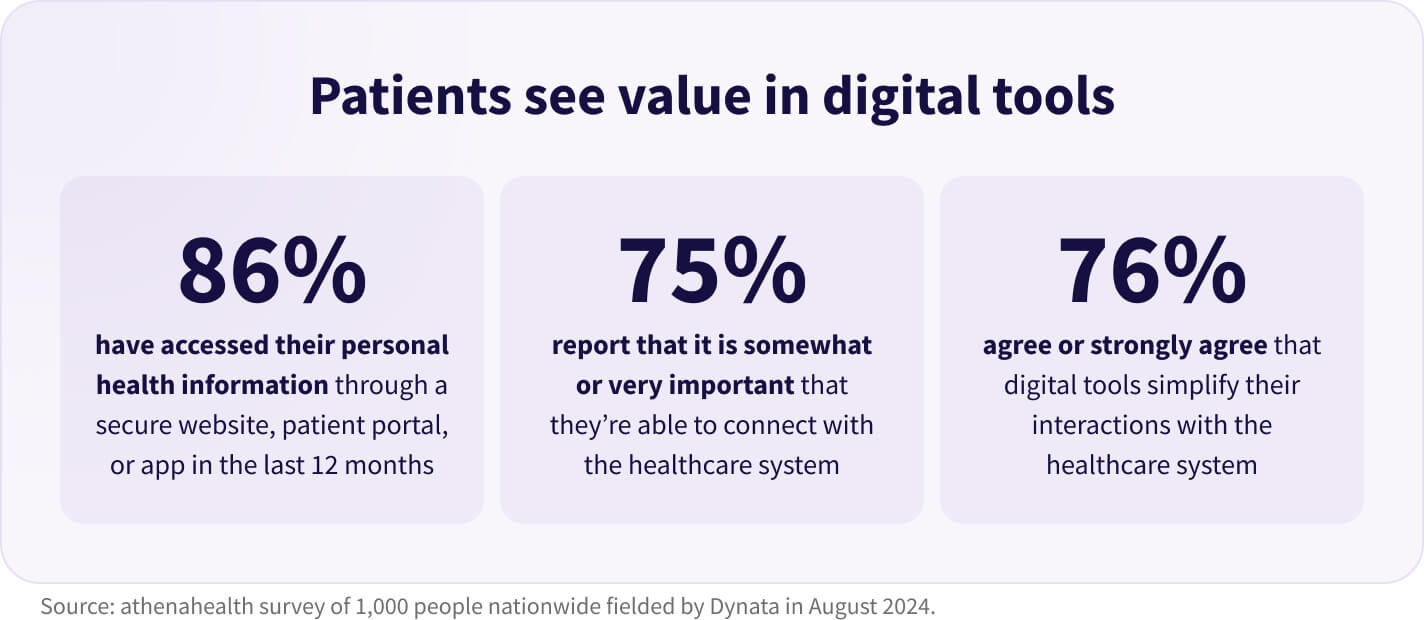Get data-backed tips to help your practice improve the digital patient experience
Patient expectations of digital tools have changed. Today, Gen Z and millennial patients are increasingly using digital tools like telehealth, patient portals, apps, and more to connect with clinicians. A 2023 survey found that 66% of Gen Z respondents use both in-person and digital healthcare, compared to only 39% in Gen X and 29% in baby boomers.1 What’s more, about 62% of Gen Z respondents are communicating with healthcare providers using patient portals.2 These younger generations of patients want to have personalized, convenient, and engaging experiences with physicians, and we’re seeing an increased need for digital patient engagement tools as a result. Patient digital engagement has become a critical barometer of practice health, especially in the age of value-based care, with many practices looking for new ways to measure patient engagement, satisfaction, and retention.
Healthcare organizations that fail to meet these evolving patient needs risk losing patients to their competitors. In order to stay afloat, practices should look to the right digital patient engagement tools to offer a simpler, more convenient digital experience for communication, payments, test results, and more. That’s why we’ve created a data-backed list of tips to help you improve the digital patient experience and drive patient satisfaction.
Key takeaways from our patient engagement study
Before we dive into the list, let’s revisit the results of our athenaOne network research using the Patient Digital Engagement Index (PDEI). The PDEI is a tool unique to athenahealth that helps practices track and measure digital patient engagement across tools that interact with our EHR, including our Marketplace partners. We track three core digital activity categories that comprise the overall PDEI score: access to care, financial activity, and accessing healthcare information—such as viewing test results online. That data is then aggregated into a total PDEI score for each practice. Tracking and measuring a PDEI score is important for practices looking to drive patient engagement, increase patient satisfaction and loyalty, and ensure financial viability of their business.
When we examined PDEI data from the athenaOne® network, including over 6,300 practices between 2021-2024, as well as data from our survey of 1,000 patients across the U.S., we found a number of critical results:
- Higher PDEI scores correlate with higher patient pay yields for practices, meaning these practices collect a higher portion of the patient responsibility from their patients and therefore write off less. A one-point increase in PDEI was found to be associated with a one-point increase in the proportion of total patient charges paid within one year.
- Women’s health and behavioral health are shown to have the highest digital engagement scores among specialties. This tracks with other key findings demonstrating that these specialties tend to have patients who are more digitally engaged.
- The most digitally engaged patients are White or Asian millennial women who live in more urban areas (as compared to other races, genders, age groups, and geographic locations).
- Initial findings revealed that clinicians working for practices with higher PDEI scores spend, on average, a lower proportion of their documentation time after hours. This finding warrants further investigation to determine what mechanisms could be contributing to the correlation between higher PDEI and decreases in “pajama time” for the physicians in these practices.
- In the patient survey, over 75% of patients agreed that digital tools simplify their interactions with the healthcare system
- Patient portals are ranked as the top digital tool in the patient survey, with over 60% of use.
Why this research is critical to improving the digital patient experience
The results of this PDEI research are not just important for providers, they’re actionable, too. Clinicians can leverage the findings from this study to improve patient engagement, retention, and satisfaction, as well as identify opportunities to improve on digital patient engagement tools.
Practices that are seeking to increase their patient pay yield and drive more revenue should look for ways they can improve patient digital engagement. For example, identifying blockers in the user experience for digital payments, whether that is done through your patient portal or another tool. If patients are having difficulty submitting payments online, practices should consider using a tool that makes patient payments quick and simple. This research also highlights patient portals as a critical tool for digital patient engagement. Assess whether your current portal is the right tool for you, or if switching to another EHR would vastly improve communication and payments done through a patient portal.
To start implementing changes that can help increase your practice’s patient digital engagement score, and drive patient satisfaction overall, begin with the lowest hanging fruit. Let’s dive into some useful tips and tricks that will help your practice learn from this research and implement positive changes when it comes to digital patient engagement.

6 tips to help your practice leverage the right tools to drive digital patient engagement
Offer the digital tools your patients want
Take advantage of the digital tools available within your EHR, patient portal, or patient app, such as patient self-scheduling, patient pay, secure messaging, and more. These tools can help you build trust with patients and strengthen your relationships over time.
Make it easier for patients to submit digital payments
Practices looking to help increase their patient pay yield and drive annual revenue should work on improving their patient digital engagement. Remove barriers for patients to submit payments digitally and encourage them to use these convenient tools wherever possible.
Encourage patient portal use for instant access to medical information
Remind patients of the benefits of using their patient portal in care settings and patient encounters. Often times the health information they’re looking for can be found instantly through the portal. Additionally, practices can focus on increasing use of the portal among those who aren’t currently the top users (older male populations living in more rural areas).
Specialties with traditionally lower digital engagement need to expand use cases
Our research shows that women’s health and behavioral health take the lead in digital engagement. For other specialties, such as orthopedics, urgent care, neurology, and more, your practice should consider methods in which you can better engage patients through digital tools. If your practice isn’t working towards increased digital engagement, your competition most likely is. Consider this an area to strengthen in the years ahead.
Train up staff on critical patient engagement tools
Train front-of-office staff in patient engagement tools so they can help patients at intake, and train clinicians to lean on patient engagement tools to communicate care plans and answer patient inquiries quickly. Clinicians can also be prepped on protocols for responding to patient messages online, so they can foster closer relationships with more digitally engaged patients.
Seek out unique tools like PDEI to help measure patient engagement
Use athenahealth’s distinct PDEI feature to help monitor your patient engagement score over time. Tracking this score helps you determine where your practice can improve and helps ensure that your score never dips.
Learning from these findings and adapting your practice to the shifting digital needs of patients can help ensure that they remain engaged. Patients who are involved and engaged in their own care are likely to have better wellness outcomes, and closer relationships to their care team. Investing in digital engagement tools can help your practice enhance the patient experience, improve satisfaction, increase patient retention, and improve practice outcomes with value-based care. By leveraging the tips listed above, clinicians can create a patient-centered experience with a lasting impact. Rather than fall behind, see where your practice might be able to implement quick and easy changes that keep patients coming back for the best care.
1. Becker’s Health IT. (May 2023). From Gen Z to Baby Boomers: Who uses digital health the most; Retrieved Jan 2025 from, https://www.beckershospitalreview.com/digital-health/from-gen-z-to-baby-boomers-who-uses-digital-health-the-most.html
2. Becker’s. 2023.












